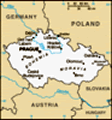Advertisement
Published: October 22nd 2017
The legendary Danube is the European Union's longest river and one of the most popular cruise itineraries offered. Most river cruises visit 4 of the 10 countries through which its not-so-blue waters flow. No other river in the world passes through so many countries. It is the second longest in all of Europe if you include Russia and the Volga River. The name of the river originates from the a mythological source, from a Latin Roman river god, known as Danubius, or Danuvius. Additionally, the meaning can actually be derived from the ancient indigenous Slavonic tribes who called it the Great Water.
The Danube runs for 1770 miles, ending up in the Black Sea via three branches. The ten countries it passes are: Ukraine, Moldova, Austria, Germany, Hungary, Slovakia, Croatia, Serbia, Bulgaria, and Romania. It starts as two little streams in Germany. It gathers water from more than 300 tributaries. In contrast, the longest river in the U.S. is the mighty Missouri River, 2341 miles long, and passing by parts of ten states. The Missouri enters the Mississippi River just north of St. Louis, MO.
"The river’s majesty has long been celebrated in music. The famous
waltz An der schönen, blauen Donau (1867;
The Blue Danube), by
Johann Strauss the Younger, became the symbol of imperial Vienna. In the 21st century the river has continued its role as an important trade artery. It has been harnessed for
hydroelectric power, particularly along the upper courses, and the cities along its banks—including the national capitals of
Vienna (Austria),
Budapest (Hungary), and
Belgrade (Serbia)—have depended upon it for their
economic growth." I will spare you the details about the Danube, but rather tell you more about its economic importance. The river provides hydroelectric power, water supply, transport, irrigation, and fishing to the surrounding ten countries. "Since
World War II, navigation has been improved by dredging and by the construction of a series of canals, and river traffic has increased considerably. The most important canals—all elements in a continentwide scheme of connecting waterways—include the
Danube–Black Sea Canal, which runs from Cernovadă, Romania, to the Black Sea and provides a more direct and easily navigable link, and the
Main–Danube Canal, completed in 1992 to link the Danube to the Rhine and thus to the
North Sea." Some of the more important cities and towns it passes are: Vienna, Bratislava, Budapest, Belgrade, and Galati (the largest port on the Danube). The Danube is navigable from the Black Sea to Bralia, Romania.
River ships can reach all the way to Bavaria. The Danube is the source of drinking water for about 20 million people. The upper Danube has upwards of 60 species of fish, the lower area has twice as much. And tourism, via both land and water travel accounts for a big portion of the economies of bordering countries. Of some importance to me, the Danube has a bicycle trail that runs the entire length of the river. These are the four main sections:
•
Donaueschingen–
Passau (559 km)
•
Passau–
Vienna (340 km)
•
Vienna–
Budapest (306 km)
•
Budapest–
Black Sea (1670 km)
The most famous portion on the Danube today is the Route of Emperors and Kings, from Regensburg to Budapest. It is a route favored by the river touring companies. The route received its name from Holy Roman Emperor Frederick I of Barbarossa and the crusaders. Sounds like a rock band? But mostly the journeys along here were taken by the Hapsburg family. There are 21 national parks and five UNESCO sites along the river as well. The river also has 16 locks, no bagels.
The Danube's delta is the second largest in the world and still growing. It is also Europe's largest wetland reserve (817,000 square kilometers), and home to over 5,000 species of plants, animals, and birds. A full third of the river's length resides in Hungary. For that reason, Budapest is often called the "Queen of the Danube." Hundreds of German warships were scuttled in 1944 to avoid capture by the Russians.
So, have I completed the river-fecta of the world? I have seen or been on the Amazon in South America, the Mississippi in the U.S., the Volga in Russia, and now the Danube in eastern Europe. Please do not award me with a cruise, as I am allergic to cruise ships!!!!
Advertisement
Tot: 0.106s; Tpl: 0.01s; cc: 14; qc: 27; dbt: 0.0473s; 1; m:domysql w:travelblog (10.17.0.13); sld: 1;
; mem: 1.1mb







